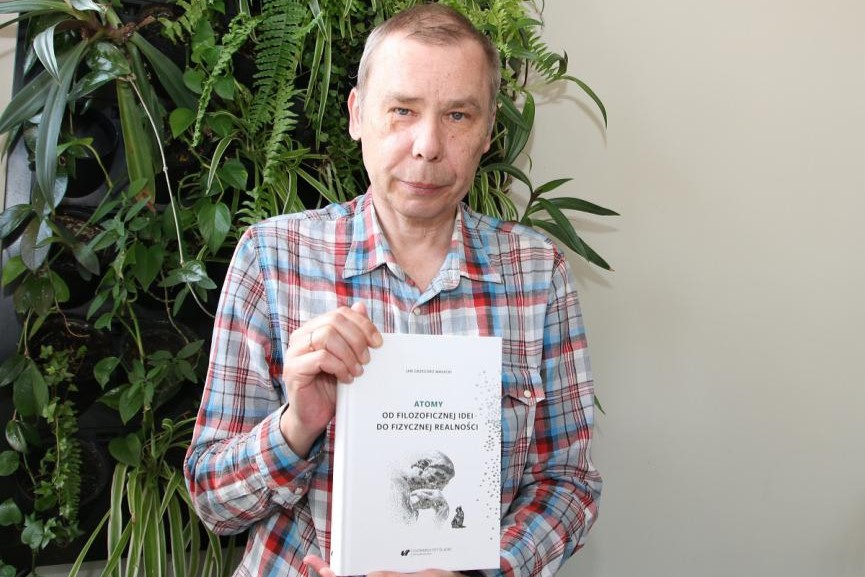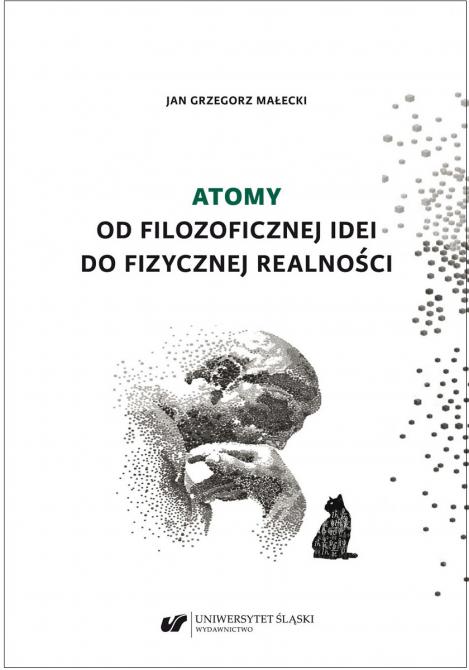Prof. Jan Małecki | photo by Małgorzata Kłoskowicz
| Małgorzata Kłoskowicz, PhD |
‘I’ve always been interested in the way leading to people to discovering something new,’ said Prof. Jan Grzegorz Małecki a few years ago, when he was telling about his popular science book entitled Historia odkryć pierwiastków chemicznych (The history of discovering chemical elements) to “Gazeta Uniwersytecka UŚ” (University of Silesia Magazine). Human biographies remained close to him. Atom. Od idei filozoficznej do fizycznej realności (Atom. From a philosophical idea to physical reality) is another publication by the scientist from the University of Silesia in Katowice, in which the history of science is combined with tales on the lives of discoverers. The author presents there the attempts to get to know and understand the smallest matter elements – from antiquity to the present day.
People have always wondered whether the smallest particles that our world consists of do exist. And if they do, what are they like? The question was, and in fact still is, philosophical. The word atom originates from Greek and refers to something indivisible. The atoms (and vacuum) were what our world supposedly consists of according to the atomic theory of Democritus, the Greek philosopher who popularised this notion. A lot has changed since then. Scientists “divided” the atom a long time ago, and then kept digging further. Everything seems to indicate that they haven’t yet said their last word about the smallest particles. Nowadays, Democritus’ atom means electrons and quarks. However, this is not the whole truth, because in the so-called spin-charge separation phenomenon, the electron behaves as if it consisted of three quasi particles.
However, there is something that connects the ancient people with the modern ones. Despite the fact that the notion of atom has changed, curiosity still lies at its source, the same question appears: is there something that could be called the smallest element of matter, and if so: what is its nature?
‘Although atom is something small, the smallest, it also proves to be an incredibly complicated, complex structure, both in terms of how we understand it and its very nature,’ says Prof. Jan Małecki.
To confirm his words, he quotes the poem written a long time ago during a student party in Caltech (California Institute of Technology):
In the beginning there was Aristotle,
And objects at rest tended to remain at rest,
And objects in motion tended to come to rest,
And soon everything was at rest,
And God saw that it was boring.
Then God created Bohr
And there was the principle,
And the principle was quantum,
And all things were quantified,
But some things were still relative,
And God saw that it was confusing.
Source: T. Joseph: Unified Field Theory
Translation: Jan G. Małecki
Some handle these complications by creating mathematical models. Others conduct experimental research. However, the history shows that even if we are already close to understanding something fundamental, something else appears that throws a new light on our considerations.
The part of the poem about quantum mechanics is the quintessence of the way we have been thinking about atoms for centuries. The modern understanding of elementary particles turns out to be interesting, especially that it does not refer to anything we could see in the macroscopic world.
‘Despite this, new terms such as “spin” make their easy way to our glossary. But what is this spin?,’ asks the scientist. ‘We do know its definition. It’s the internal angular momentum of an electron, but so what? What does it mean?,’ he adds, and immediately recalls the story of George Uhlenbeck and Samuel Goudsmit, two scientists in their twenties who proposed the introduction of this term back in 1925. They had some doubts over their theory, which were also shared by Hendrik Lorents, once he performed his calculations. They showed that if we treat electron as a particle that revolves around itself, a point on the electron’s surface would have to move four times faster than the light. However, it was too late for changes, because the article had already been sent to the scientific journal „Naturwissenschaften”.
‘That was a funny story. When Samuel Goudsmit expressed his concerns aloud, he heard from his superior that in fact he could publish just about anything, because being a young scientist, he had nothing to lose. We know how the story ended. Nowadays, it is not possible to talk about the quantum nature of particles without the notion of spin,’ says Prof. Jan Małecki.
Not only this notion appears to be unclear. Another interesting word that comes up in atomic theories is whirl. Therefore, we go back to Carthesius. This French scholar living at the turn of the 16th century assumed that there was nothing like a vacuum. He adopted the notion of whirls in order to explain magnetic phenomena and gravity. The whirls were supposedly built of moving spiral particles with a definite shape.
‘From our perspective, this idea seems unclear nowadays. However, it can be assumed that particle has been perceived as something real precisely since Carthesius. He was the first to wipe that that glass, and although the view still seemed blurry, it was possible to find an interesting trace there, a clue,’ says the scientist.
John Dalton’s concept settled the question of atom’s realness, he adds. At the beginning of the 19th century, the English scholar announced his theory, according to which the elements (matter) consists of atoms taking the shape of resilient spheres.
‘I think that most of us associate atom’s construction with the image of a system of connected spheres,’ sums up the scientist.
That was not the end of discoveries. Neither is this the end of the list of the names of scholars who brought us closer to our understanding of atom nowadays thanks to their curiosity and research.
We can find almost one hundred of them in a table of contents, starting with Carthesius and ending with Robert Hofstadter, American physicist and Nobel Prize winner in 1961 for his research on electrons and nucleons. The stories of many of these scientists were recorded in Prof. Jan Małecki’s publication.
The book contains interesting facts about the lives of Isaac Newton, Niels Bohr, Michael Faraday, Maria Skłodowska-Curie… We find out that Robert Hook, the 18th century English natural scientist and one of the great experimenters, suffered from strong headaches as a young man. The source of his migraines were the lessons taught by his father. However, sleeplessness, tinnitus, haemorrhages and melancholy fits did not prevent him from making multiple discoveries and building various inventions, such as vacuum pump and hygrometer. Robert Hooke was also an atomist. He thought that material bodies consist of particles being in constant movement, whereby their velocity depends on their mass.
Even if biographical facts are not directly connected with the scientific discoveries (or maybe they do?), they can help the book reach a wider audience.
‘We will not find there mathematical formulas, there are no complex, sublime transformations.
Above all, I tried to get the reader interested in the tale about what comes out of the formula for our understand of atom,’ says Prof. Jan Małecki. ‘And since there is a lot of information preserved about the life of 17th and 18th century scientists, I also decided to include it in my book.
What is the atom today? The answer really depends on the fields of science. A physicist or a chemist would respond to it differently. I’m a chemist, so from my perspective atom is an element of the matter which contains a nucleus with protons and neutrons. I do not go into gluons, mesons or other beautiful particle names. From the point of view of chemistry, they are not as important,’ says the book’s author.
‘There are also electrons. What are they? Some processes reveal their partial nature, in others they seem to be wavy. As a matter of fact, electron is neither a particle nor a wave. Once again we are back to our imagination, so limited,’ he adds. He goes on to recall the name of Max Planck who came up with the term wave packet.
‘Let’s try to imagine what a wave packet is. This is the same level of abstraction as the notion of spin. There is no model that could help us understand or visualize what we are facing. Whether we, scientists, really need such representation, is yet another story. For us math must be sufficient, and it is,’ sums up Pro. Jan Małecki.
The book Atomy. Od filozoficznej idei do fizycznej realności (Atoms. From a philosophical idea to a physical realness) was published in 2023 by the University of Silesia Press.
The article entitled „Zagmatwana natura atomu” (The confusing nature of atom) was published in the May issue of „Gazeta Uniwersytecka UŚ (University of Silesia Magazine) University of Silesia” no. 8 (308).







